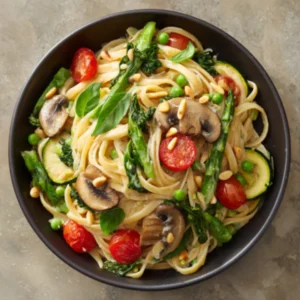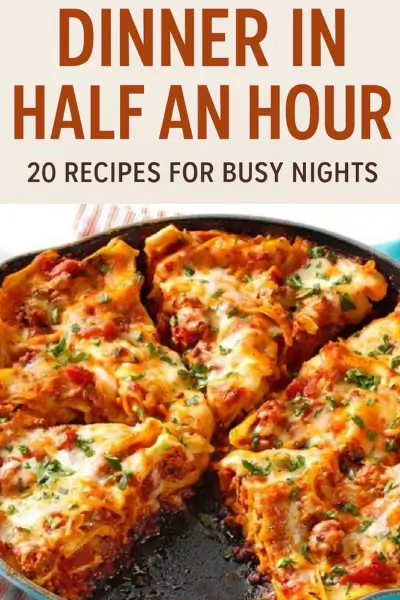Pasta Primavera is a creamy pasta dish with plenty of fresh vegetables. It’s simple, colorful, and full of flavor. You get a comforting meal that’s easy to make and perfect for any day of the week.
Why We Love This Pasta Primavera Recipe
There’s a lot to love about Pasta Primavera. First and foremost, it’s incredibly versatile. You can use whatever vegetables are in season or hanging out in your fridge. From the snap of snow peas to the softness of mushrooms, every ingredient adds its own texture and flavor.
The cream sauce is another star of the show. It’s made with butter, cream, and Parmigiano Reggiano—a trio that creates a silky base for your pasta and vegetables. Yet, thanks to the generous portion of veggies, the dish still feels light and satisfying. Plus, the toasted pine nuts at the end add a delightful crunch and a nutty aroma that sets this dish apart from typical creamy pastas.
What’s more, Pasta Primavera is perfect for sharing. It looks beautiful when plated, with all those bright greens and reds, making it a hit at any dinner table. Whether it’s a weeknight meal or a weekend gathering, this dish delivers flavor, style, and comfort all in one bowl.
Ingredients about Pasta Primavera
- 300g / 10 oz linguine (or other long, flat pasta)
Vegetables:
- 150g / 5 oz white mushrooms, sliced
- 1/2 large zucchini, sliced into rounds
- 1 bunch broccolini
- 1 1/2 cups snow peas (about 10 pieces)
- 1 bunch green asparagus (8 to 10 spears)
- 1 cup green peas, defrosted
- 10 cherry tomatoes, halved
- 2 garlic cloves, finely minced
Cream Sauce:
- 5 tbsp / 75g unsalted butter
- 1 cup thickened or heavy cream
- 1/2 cup finely grated Parmigiano Reggiano (or parmesan)
Cooking Additions:
- 3 tbsp extra virgin olive oil
- 1/3 cup pasta cooking water
- 1 tsp cooking/kosher salt
- 1/4 tsp black pepper
- 1/2 cup fresh basil leaves, finely sliced
- 2 tbsp pine nuts, toasted
How to Make Pasta Primavera Directions
Start by preparing all your vegetables. Slice the mushrooms thinly and cut the zucchini into neat rounds. For the broccolini, remove the florets and slice the stems diagonally into 1-inch pieces. Snap the ends off the asparagus where they naturally break and slice the stems. Remove the strings from the snow peas and cut them on a diagonal. Set all vegetables aside, organized and ready for quick cooking.
Now move on to the cream sauce. In a medium saucepan over medium-high heat, melt the butter. Add the cream and Parmigiano Reggiano. Stir continuously until the cheese melts completely and the sauce thickens slightly. Once it begins to simmer gently, take it off the heat. This step is crucial for getting that silky texture without breaking the sauce.
Bring a large pot of salted water to a rolling boil. Add your linguine and cook it according to the package instructions, minus one minute. Just before draining, reserve 1/3 cup of the pasta water and set it aside. This starchy liquid helps your sauce cling to the pasta beautifully.
Next, heat half of the olive oil in a large skillet over high heat. Sauté the mushrooms for about 4 minutes until they turn golden. Remove them from the skillet and set aside. Add the remaining oil to the skillet and toss in the broccolini, snow peas, and asparagus. Cook these for 2 minutes.
Add the zucchini, cherry tomatoes, green peas, garlic, salt, and pepper. Cook everything together for another 3 minutes. Return the mushrooms to the skillet and give it all a good mix. Remove the pan from heat.
Transfer your drained pasta back into the now-empty pot. Add the sautéed vegetables, cream sauce, and reserved pasta water. Toss everything together over medium heat. Keep mixing until the sauce thickens and evenly coats the pasta. This should take about 1 to 2 minutes. If the sauce feels too thick, add a splash more of the pasta water and stir.
Finally, add the freshly sliced basil and give it one last toss. Serve the pasta in bowls, garnished with toasted pine nuts for that final aromatic crunch.
How to Serve Pasta Primavera
Serving Pasta Primavera is all about presentation and timing. Because the vegetables are cooked to a tender-crisp texture, it’s best served immediately while everything is still warm and the sauce is at its silkiest.
Use shallow bowls to serve, as this helps showcase the colorful vegetables and allows the sauce to settle nicely at the bottom. You can sprinkle a little extra Parmigiano Reggiano over each portion if desired. Don’t forget a final scattering of toasted pine nuts—they add visual appeal and an extra burst of flavor with every bite.
Pair this dish with something light like a simple green salad or warm crusty bread. You’ll want something that complements the richness without overshadowing the creamy vegetable medley. And yes, it’s absolutely satisfying all on its own as a complete main.
Expert Tips: Pasta Primavera
- Prep everything first: Since timing is crucial, have all your vegetables chopped and ready before you start cooking. It makes the process smoother and prevents overcooking.
- Don’t overcook the veggies: The beauty of Pasta Primavera lies in its crisp-tender vegetables. Overcooked vegetables turn mushy and lose their bright colors and textures.
- Use starchy pasta water: That 1/3 cup of reserved pasta water is magic. It helps bind the sauce to the pasta and gives it that perfect creamy consistency.
- Fresh herbs matter: If you can get fresh basil, use it. It adds a level of freshness and brightness that dried herbs just can’t match.
- Toast the pine nuts: Don’t skip this. It only takes a minute or two in a dry skillet, but it makes a noticeable difference in taste and aroma.
How to Store Pasta Primavera
If you happen to have leftovers, Pasta Primavera can be stored in an airtight container in the refrigerator for up to 3 days. Let it cool completely before sealing it up.
When reheating, it’s best to use the stovetop. Add a splash of milk or cream to loosen the sauce as it heats. Stir frequently to ensure everything warms evenly without drying out.
Microwave reheating works too, but you’ll want to pause and stir halfway through for even heating. Avoid freezing this dish, as the cream sauce and fresh vegetables don’t hold up well to freezing and thawing.
Variation of Pasta Primavera
One of the best things about Pasta Primavera is how flexible it is. You can swap in a variety of vegetables depending on the season or your preferences.
- Try red bell peppers or yellow squash for added color and sweetness.
- Use baby spinach or kale for a leafy green addition.
- Add protein by tossing in cooked chicken, shrimp, or chickpeas.
- Switch out the cream sauce for a light olive oil and garlic version if you want a dairy-free alternative.
- Change up the pasta. Penne, rotini, or even gluten-free options work just as well.
This dish is like a canvas. You get to make it your own, whether you’re going for something heartier or a bit lighter.
FAQ about Pasta Primavera
What does Pasta Primavera mean?
“Primavera” means “spring” in Italian. Pasta Primavera refers to pasta made with spring vegetables, though you can enjoy it year-round with whatever produce you have.
Can I make Pasta Primavera vegan?
Yes, you can! Use plant-based butter, non-dairy cream, and a vegan parmesan alternative. The vegetables and pasta are naturally vegan-friendly.
Why do I need pasta water in this recipe?
Pasta water contains starch, which helps bind the sauce to the pasta, giving you a creamy, cohesive dish.
Can I use other types of pasta?
Absolutely. While long, flat pasta works best for holding the sauce, you can use penne, farfalle, or whatever you have on hand.
What can I substitute for pine nuts?
If you don’t have pine nuts, try toasted slivered almonds or chopped walnuts for a similar crunch and nutty flavor.
Is Pasta Primavera good for meal prep?
It can be, but it’s best enjoyed fresh. If making ahead, store components separately and combine just before serving for the best texture.
How can I make it lighter?
Reduce or omit the butter and oil. Use less cream or substitute with milk. You’ll still get great flavor with fewer calories.

Pasta Primavera
Ingredients
- 300 g linguine (or other long, flat pasta)
- 150 g white mushrooms (sliced)
- 1/2 large zucchini (sliced into rounds)
- 1 bunch broccolini
- 1 1/2 cups snow peas (about 10 pieces)
- 1 bunch green asparagus (8 to 10 spears)
- 1 cup green peas (defrosted)
- 10 pieces cherry tomatoes (halved)
- 2 cloves garlic (finely minced)
- 5 tablespoons unsalted butter (75g)
- 1 cup thickened or heavy cream
- 1/2 cup Parmigiano Reggiano (finely grated or parmesan)
- 3 tablespoons extra virgin olive oil
- 1/3 cup pasta cooking water
- 1 teaspoon cooking/kosher salt
- 1/4 teaspoon black pepper
- 1/2 cup fresh basil leaves (finely sliced)
- 2 tablespoons pine nuts (toasted)
Instructions
- Prepare the vegetables: slice mushrooms, cut zucchini into rounds, remove florets from broccolini, snap ends off asparagus, and prepare snow peas.
- In a medium saucepan over medium-high heat, melt the butter. Add cream and Parmigiano Reggiano, stirring until the cheese melts and sauce thickens slightly. Remove from heat.
- Bring a large pot of salted water to a boil. Add linguine and cook according to package instructions, minus one minute. Reserve 1/3 cup pasta water before draining.
- In a large skillet, heat half of the olive oil over high heat. Sauté mushrooms for about 4 minutes until golden. Remove and set aside.
- Add remaining olive oil to the skillet, toss in broccolini, snow peas, and asparagus, and cook for 2 minutes. Then add zucchini, cherry tomatoes, green peas, garlic, salt, and pepper. Cook for another 3 minutes.
- Return mushrooms to skillet, then transfer drained pasta back into the pot. Add sautéed vegetables, cream sauce, and reserved pasta water. Toss over medium heat until sauce thickens and coats pasta (1-2 minutes).
- Stir in freshly sliced basil and serve in bowls, garnished with toasted pine nuts.
Send me this recipe!
Just enter your email below and get it sent straight to your inbox!



